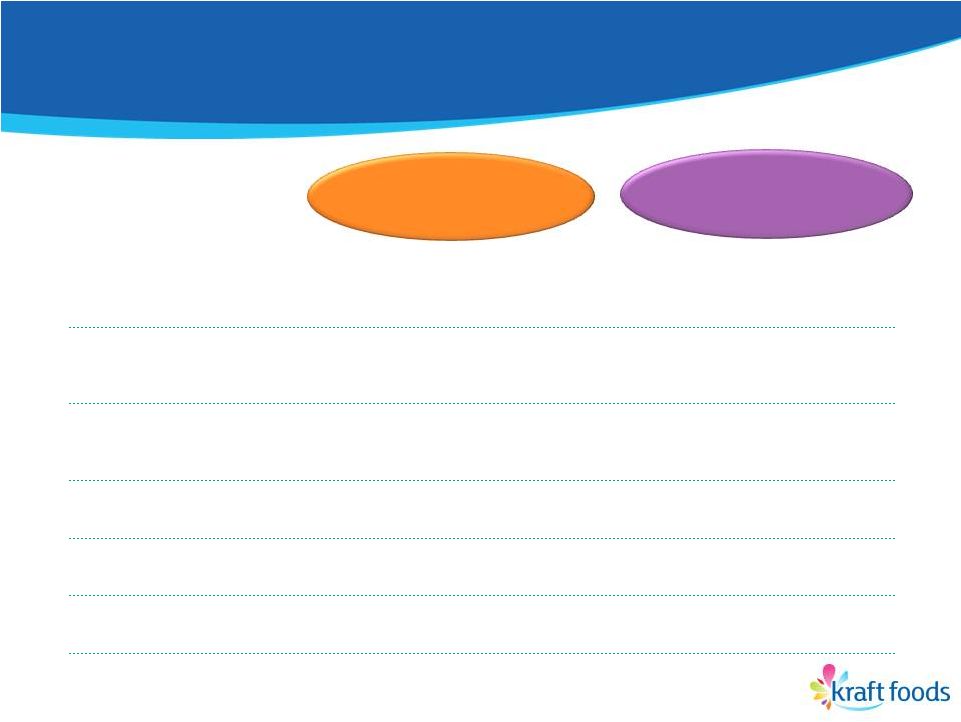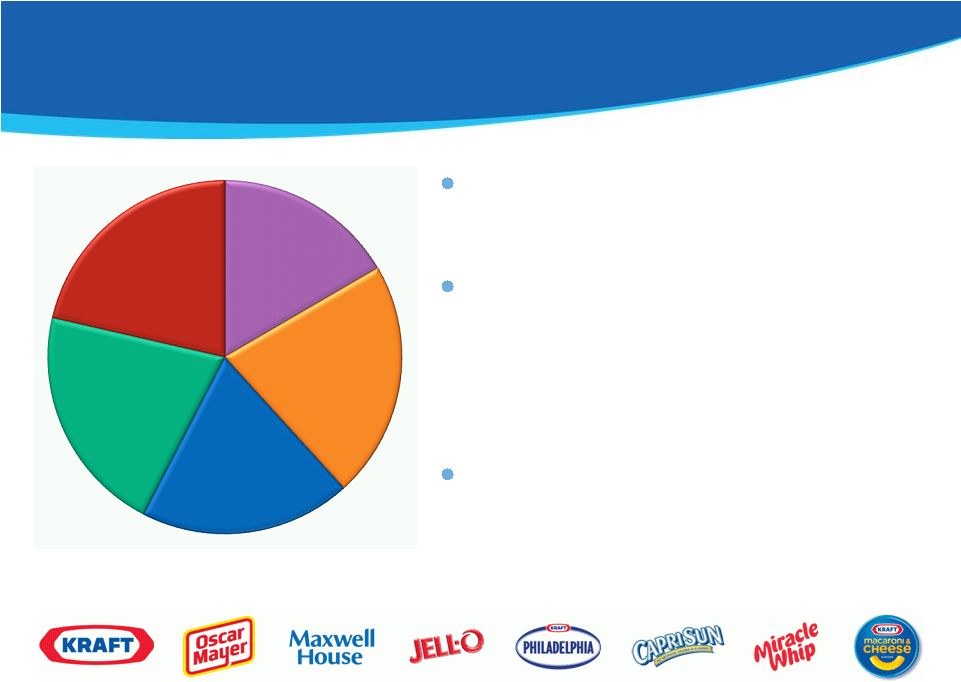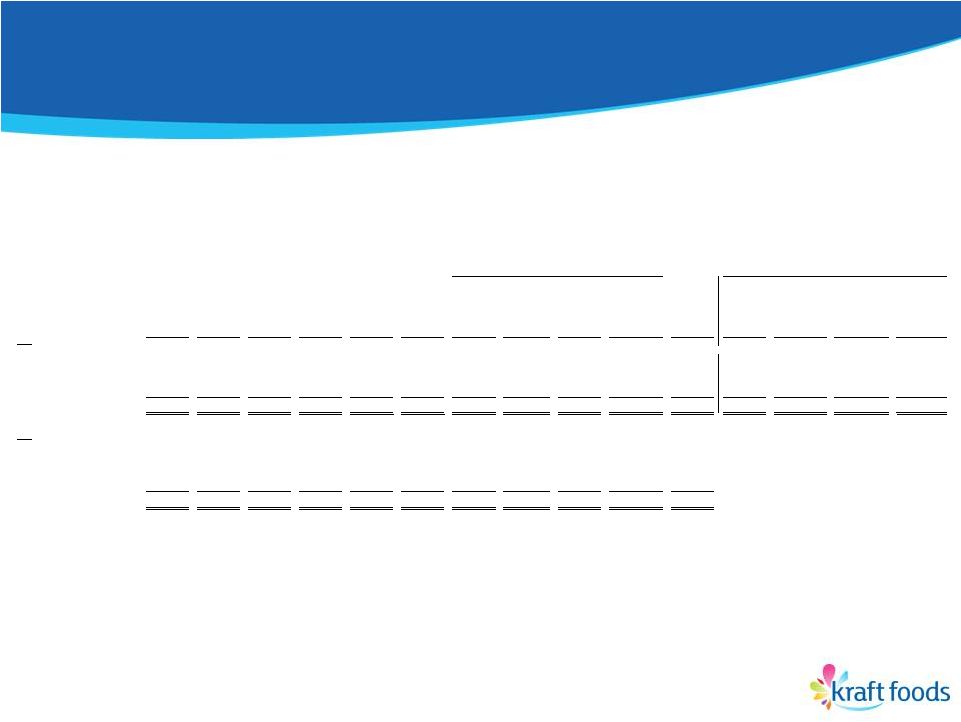Attached files
| file | filename |
|---|---|
| 8-K - FORM 8-K - Mondelez International, Inc. | d8k.htm |
| EX-99.1 - KRAFT FOODS INC. PRESS RELEASE, DATED SEPTEMBER 7, 2011. - Mondelez International, Inc. | dex991.htm |
 Kraft
Foods Barclays Capital
Back-to-School Conference
September 7, 2011
Exhibit 99.2 |
 Irene
Rosenfeld Chairman and CEO |
 Forward-looking statements
This
slide
presentation
contains
a
number
of
forward-looking
statements.
The
words
“believe,”
“expect,”
“anticipate,”
“optimistic,”
“intend,”
“plan,”
“goals,”
“may,”
“aim,”
“will”
and similar
expressions
are
intended
to
identify
our
forward-looking
statements.
Examples
of
forward-
looking statements include, but are not limited to, statements we make regarding being
well- positioned for sustainable growth; two distinct portfolios poised for peak
performance; top-line growth; 2011 guidance; top-tier organic revenue growth;
EPS growth; North America Grocery business description and performance; position within
the new reality of the U.S. food industry; Global Snacks business description, ranking,
geographic profile and performance; benefits from creating two independent entities;
and what’s next. These forward-looking statements involve
risks and uncertainties, many of which are beyond our control, and important factors that
could cause actual results to differ materially from those in the forward-looking
statements include, but are not limited to, increased competition, pricing actions,
continued volatility and increases in commodity costs, increased costs of sales, our
indebtedness and our ability to pay our indebtedness, risks from operating globally,
our failure to successfully execute in emerging markets,
our
failure
to
create
two
success
independent
companies
and
tax
law
changes.
For
additional information on these and other factors that could affect our forward-looking
statements, see our risk factors, as they may be amended from time to time, set forth
in our filings with the SEC, including our most recently filed Annual Report on Form
10-K and subsequent reports on Forms 10-Q and 8-K.
We disclaim and do not undertake any obligation
to update or revise any forward-looking statement in this slide presentation, except as
required by applicable law or regulation.
3 |
 Why now?
•
Well-Positioned for Sustainable Growth
•
Two Distinct Portfolios Poised for Peak
Performance
4 |
 Three key
ingredients to sustainable growth •
Fix our base
–
Rewire the organization
–
Rejuvenate our brands
5
Kraft
Foods
Base
Business
(1)
% of Products Preferred to Competition
(1)
Excludes Cadbury.
Source: Kraft Foods. |
 Three key
ingredients to sustainable growth •
Fix our base
•
Transform the portfolio
–
Strengthen North American
business
–
Build a global snacks
powerhouse
6 |
 Three key
ingredients to sustainable growth •
Fix our base
•
Transform the portfolio
•
Make Virtuous Cycle
work in each region
–
Sustainable, top-tier growth
7
Focus on Power
Brands,
Categories,
Markets
Drive Top-Tier
Growth
Reduce Costs
Leverage Overheads
Reinvest in
Growth |
 Top-line
growth accelerating in each region 8
Organic Net Revenue Growth*
North America
Developing Markets
Europe
*
For 2010, reflects Combined Organic Net Revenue growth. Reported Net Revenue growth for
2010 were as follows: North America, 8.8%; Europe, 32.6%; Developing Markets,
71.1%. Reported Net Revenue growth for H1 2011 were as follows: North America,
3.4%; Europe, 18.9%; Developing Markets, 23.1%. See GAAP to Non-GAAP reconciliation
at the end of this presentation. 1.1%
3.1%
2010
H1 2011
9.5%
11.6%
2010
H1 2011
2.3%
5.4%
2010
H1 2011 |
 Strong H1
operating momentum in each geography
•
Executed necessary pricing
–
Quickly responded to higher input costs
•
Winning with consumers
–
Focused brand investments, innovation and improved
marketing
–
Solid share performance while pricing earlier than competition
•
Grew profit dollars versus difficult comparisons
–
Driving End-to-End Cost Management
–
Funding strong increase in A&C
9 |
 Snacks
portfolio up more than 6% in H1 *
•
Global Biscuits +7% through H1
*
–
Developing Markets up strong double-digits
–
Oreo
+22%,
Chips
Ahoy!
+18%,
Club
Social
+35%
•
Global Chocolate +9% through H1
*
–
Developing Markets up low-to-mid teens
–
Cadbury
Dairy
Milk
+13%,
Lacta
+18%,
Cadbury
Flake
+13%
•
Global Gum & Candy +2% through H1
*
–
Developing Markets up high single-digits
–
Fixing developed markets through advertising, innovation
and price points
10
* Reflects H1 2011 Organic Net Revenue Growth. Reported H1 2011 Net Revenue growth was
16.7% for Snacks, 10% for Biscuits and 22.5% for Confectionery, which is
comprised of 26.2% for Chocolate, 24.3% for Gum & Candy and (37.1)% for Other
Confectionery. See GAAP to Non-GAAP reconciliation at the end of this presentation. |
 Increased 2011
guidance with Q2 results •
Organic Net Revenue growth of at least 5%
–
Taking additional pricing to address climbing input costs
•
Operating EPS of at least $2.25
–
Delivering strong operating results
–
Reflecting year-to-date currency benefit
11 |
 Delivering
top-tier organic revenue growth 12
1
ConAgra
9.5%
1
General Mills
8.5%
1
Danone
6.9%
1
Danone
6%-8%
2
Danone
8.4%
2
ConAgra
7.7%
2
Hershey
6.1%
2
PepsiCo
6%-8%
3
Nestlé
8.3%
3
Heinz
5.5%
3
Coca-Cola
6.0%
3
Nestlé
6%
4
General Mills
8.2%
4
Nestlé
4.1%
4
Nestlé
6.0%
4
Hershey
~6%
5
Heinz
6.9%
5
Coca-Cola
4.0%
5
General Mills
4.0%
5
Coca-Cola
5%-6%
6
Kraft Foods
6.7%
6
Hershey
4.0%
6
Kraft Foods
3.5/3.7%
6
Kraft Foods
5%+
7
PepsiCo
6.6%
7
PepsiCo
4.0%
7
PepsiCo
3.5%
7
Sara Lee
4.9%
8
Coca-Cola
5.7%
8
Danone
3.2%
8
Heinz
2.1%
8
Kellogg
4%-5%
9
Kellogg
5.4%
9
Campbell
3.0%
9
ConAgra
(0.8)%
9
General Mills
2.0%
10
Sara Lee
4.6%
10
Kellogg
3.0%
10
Kellogg
(1.3)%
10
Heinz
1.9%
11
Hershey
3.4%
11
Sara Lee
2.7%
11
Campbell
(2.0)%
11
ConAgra
1.1%
12
Campbell
3.0%
12
Kraft Foods
1.5%
12
Sara Lee
(2.8)%
12
Campbell
(2.0)%
(1)
Reported Net Revenue growth was 27.0%; Combined Organic Net Revenue Growth was 3.5%; Kraft
Foods Base Organic Net Revenue
growth
was
3.7%.
See GAAP to Non-GAAP reconciliation at the end of this presentation.
(2)
Per company reports.
(3)
PepsiCo reflects the company’s medium-term target. Coca-Cola reflects the
company’s long-term target. (4)
As reported.
Organic Revenue Growth (Fiscal Year)
*
2008
2009
2010
2011E
(2)
(1)
(4)
(4)
(4)
(4)
(3)
(3)
* Source: Thomson First Call. |
 Poised to
improve EPS growth versus peers 13
1
ConAgra
32.9%
1
Hershey
15.4%
1
Hershey
17.5%
1
Kraft Foods
11.4%+
2
Sara Lee
19.3%
2
General Mills
13.1%
2
General Mills
15.6%
2
Coca-Cola
11.2%
3
Coca-Cola
16.7%
3
Heinz
10.3%
3
ConAgra
14.5%
3
Hershey
11.0%
4
General Mills
10.7%
4
Kraft Foods
8.0%
4
Coca-Cola
14.1%
4
Danone
10.3%
5
Heinz
10.5%
5
Campbell
6.2%
5
PepsiCo
11.3%
5
General Mills
7.8%
6
PepsiCo
8.9%
6
Kellogg
5.7%
6
Campbell
11.3%
6
PepsiCo
7.7%
7
Kellogg
8.3%
7
PepsiCo
0.8%
7
Nestlé
7.4%
7
Heinz
7.3%
8
Campbell
7.2%
8
Nestlé
0.7%
8
Danone
5.4%
8
Kellogg
5.8%
9
Nestlé
4.0%
9
Danone
(0.8)%
9
Kraft Foods
4.7%
9
Sara Lee
2.6%
10
Kraft Foods
3.3%
10
Coca-Cola
(2.9)%
10
Kellogg
4.4%
10
Campbell
0.8%
11
Danone
1.2%
11
Sara Lee
(15.2)%
11
Heinz
(1.0)%
11
ConAgra
0.6%
12
Hershey
(9.6)%
12
ConAgra
(20.0)%
12
Sara Lee
(9.5)%
12
Nestlé
(7.8)%
2008
2009
2010
2011E
Operating EPS Growth
(1)
(2)
(4)
(4)
(4)
(4)
(3)
(1)
Source: Thomson First Call.
(2)
Represents Operating EPS. Reported Diluted EPS declined 23.8%. See GAAP to
Non-GAAP reconciliation at the end (3)
Based on Operating EPS guidance of at least $2.25. (4)
As reported.
of this presentation. |
 Well-positioned to deliver top-tier growth
14
Focus on Power
Brands, Categories,
Markets
Drive Top-Tier Growth
Reduce Costs
Leverage Overheads
Reinvest in Growth |
 Why now?
•
Well-Positioned for Sustainable Growth
•
Two Distinct Portfolios Poised for Peak
Performance
15 |
 Significant
differences in operating models of NA Grocery and Global Snacks
16
North American
Grocery
Global
Snacks
Categories/Brands
Regional
Global
Products
Everyday Staples
Ubiquitous,
Discretionary
Store Presence
Center of Store
Snacking Aisle,
End Caps, Hot Zone
Sales & Distribution
Warehouse
DSD, High Touch
Cost Structure
Low,
Variable
High,
Fixed
Selling Costs
Modest
High |
 17
Two strong portfolios with unique drivers
of success
North American
Grocery
Global
Snacks |
 North American
Grocery will be a major force in the industry
18
U.S.
Beverages
17%
$16 Billion in Revenues
*
U.S. Cheese
22%
U.S.
Convenient
Meals
19%
U.S. Grocery
22%
Canada &
NA Foodservice
20%
Significant scale across categories
—
#3 in size to Nestle and PepsiCo
#1 in ~80% of categories
—
Four $1B+ brands…
Kraft, Maxwell
House,
Oscar Mayer, Philadelphia
—
Three $500MM-$1B brands
—
Fourteen $100MM-$500MM brands
Biggest and best grocery sales
force in U.S.
—
Highest rated in Cannondale and
Kantar
—
Gaining share with key customers
* Based on 2010 reported net revenues adjusted for accounting calendar changes and
divestitures, including the Starbucks CPG business. |
 Well-positioned within the new reality
of the U.S. food industry
19
* Excludes Cookies, Crackers and Snack Nuts
Source: Nielsen.
’07-’09
CAGR
2010
5.3%
1.9%
Kraft Foods Categories
*
’07-’09
CAGR
2010
5.0%
0.3%
Total U.S. Food & Beverage |
 North American
Grocery will deliver consistent growth, significant free cash flow
20
•
Moderate growth in line with categories
–
Innovation and marketing excellence
–
Disciplined portfolio management
–
Grocery channel scale
•
Strong margins with upside opportunity
–
Trade spend optimization
–
Lean Six Sigma
–
Negative overhead growth
–
High dividend payout, growing dividend over time
Substantial
free
cash
generation
• |
 Global Snacks
will be the pre-eminent player in snacking worldwide
21
#1 player in global snacks
—
#1 in Biscuits
—
#1 in Chocolate
—
#2 in Gum
Strong stable of global and
local icons
—
Eight $1B+ brands …
Cadbury,
Jacobs,
LU,
Milka, Nabisco, Oreo, Tang, Trident
—
Six $500MM-$1B brands
—
Nearly 40 $100MM-$500MM brands
Beverages to drive strong growth
with high margins
* Based on 2010 reported net revenues adjusted for accounting calendar changes and
divestitures. ** Includes salted snacks
Chocolate
26%
$32 Billion in Revenues
*
Gum &
Candy
16%
Biscuits
**
33%
Beverages
16%
Cheese &
Grocery
9%
•
•
• |
 (1)
Global Snacks will rank among the leading
CPG players in developing markets
22 Avon
Percentage of Revenues from Developing Markets
Colgate
P&G
Danone
Kimberly
Clark
Heinz
PepsiCo
Coca-
Cola
Campbell
Soup
Nestlé
Clorox
Sara Lee
Unilever
Kellogg
General
Mills
68%
53%
50%
49%
42%
39%
35%
34%
32%
31%
23%
21%
17%
14%
11%
8%
(1)
Reflects the percentage of revenues from Developing Markets of the proposed Global Snacks
company.
Source: Company reports and presentations, reflecting the following: Avon -
Emerging & developing markets per CAGNY 2011 presentation; Unilever -
Emerging markets per 2010 annual report; Colgate - Emerging markets per CAGNY 2011
presentation; Danone - Emerging markets pro forma for Unimilk per 2010 results
presentation; Nestle - Emering markets approaching 40% of sales per full year 2010 results roadshow; P&G - Developing markets per fiscal
2011 10-K; Coca-Cola - Pacific, Latin America, Eurasia & Africa excluding
Bottling Investments; Kimberly-Clark - Asia, Latin America and Other; PepsiCo -
Emerging markets pro forma for Wimm-Bill-Dann per CAGNY 2011 presentation; Heinz -
Emerging markets per Q1 2012 earnings release; Campbell - Australia/Asia
Pacific, Other; Sara Lee - Other; Kellogg - Latin America, Asia Pacific; General Mills - Asia Pacific, Latin America.
|
 23
Latin
America
CEEMA
Asia
Pacific
Europe
36%
North
America
22%
Developing
Developing
Markets
Markets
42%
42%
$32 Billion in Revenues
*
Well-balanced Developing
Markets presence
—
Scale and profitable growth in key
developing markets
Strong presence, prospects in
Europe
—
Significant synergies, whitespace
opportunities
Lower-than-average exposure
to North America
—
Instant Consumption Channel
expansion
* Based on 2010 reported net revenues adjusted for accounting calendar changes and
divestitures. •
•
•
Global Snacks’
geographic profile is
unique within consumer products |
 Global Snacks
will deliver exceptional growth 24
•
Industry-leading growth
–
Global product platforms
–
Developing Market presence
–
Instant Consumption Channels
–
Whitespace opportunities
•
Leverage cost structure to drive margin gains
–
Volume growth and improved product mix
Reinvest to support future growth
Top-tier EPS growth plus a modest dividend
•
• |
 Several
important benefits from creating two independent entities
•
Enable focus on distinct strategic priorities
–
Customize operating models, cultures, organizational
structures
•
Optimize resource allocation and capital deployment
–
North American Grocery resources dedicated to the
Grocery business
•
Increase transparency for shareholders
–
Value each business versus respective peer set
–
Expand shareholder base
25 |
 What’s
Next •
Continue to report as one company
•
Tax Rulings by early Q2
•
Initial Form 10 filing during Q2
•
Complete transaction no later than Dec. 31, 2012
26 |
 27
Summary
•
Strong business momentum
•
Virtuous cycle at work in every region
•
Taking next logical step in evolution of Kraft Foods |
 |
 29
GAAP to Non-GAAP Reconciliation
As Reported
(GAAP)
Impact of
Divestitures
Impact of
Acquisitions
Impact of
Integration
Program
Impact of
Currency
Base Kraft
Foods
Organic
(Non-GAAP)
Impact of
Acquisitions -
Cadbury
(1)
Divestitures -
Cadbury's
Poland and
Romania
Operations
(1)
Impact of
Currency -
Cadbury
(1)
Cadbury
Organic
(Non-GAAP)
(1)
Combined
Organic
(Non-GAAP)
As Reported
(GAAP)
Base Kraft
Foods Organic
(Non-GAAP)
Cadbury
Organic
(Non-GAAP)
(1)
Combined
Organic
(Non-GAAP)
2010
Kraft Foods North America
23,966
$
(21)
$
(1,498)
$
-
$
(251)
$
22,196
$
1,498
$
-
$
(35)
$
1,463
$
23,659
$
8.8%
1.1%
0.8%
1.1%
Kraft Foods Europe
11,628
-
(2,892)
-
267
9,003
2,892
-
91
2,983
11,986
32.6%
2.9%
0.7%
2.3%
Kraft Foods Developing Markets
13,613
-
(4,753)
1
15
8,876
4,753
(105)
(302)
4,346
13,222
71.1%
11.8%
5.1%
9.5%
Kraft Foods
49,207
$
(21)
$
(9,143)
$
1
$
31
$
40,075
$
9,143
$
(105)
$
(246)
$
8,792
$
48,867
$
27.0%
3.7%
2.9%
3.5%
2009
Kraft Foods North America
22,030
$
(80)
$
-
$
-
$
-
$
21,950
$
1,452
$
-
$
-
$
1,452
$
23,402
$
Kraft Foods Europe
8,768
(15)
-
-
-
8,753
2,961
-
-
2,961
11,714
Kraft Foods Developing Markets
7,956
(14)
-
-
-
7,942
4,341
(207)
-
4,134
12,076
Kraft Foods
38,754
$
(109)
$
-
$
-
$
-
$
38,645
$
8,754
$
(207)
$
-
$
8,547
$
47,192
$
(1)
Net Revenues to Combined Organic Net Revenues
For the Twelve Months Ended December 31,
($ in millions, except percentages) (Unaudited)
Add back:
% Change
Kraft Foods acquired Cadbury plc on February 2, 2010. Cadbury data, shown above, is for February
through December 2010 and 2009, adjusted from IFRS to U.S. GAAP and translated to US$ from local countries' currencies.
Cadbury 2009 data is presented on a combined company, pro forma basis.
|
 30
GAAP to Non-GAAP Reconciliation
As Reported
(GAAP)
Impact of
Divestitures
(1)
Impact of
Acquisitions
(2)
Impact of
Accounting
Calendar
Changes
Impact of
Currency
Organic
(Non-GAAP)
As Reported
(GAAP)
Organic
(Non-GAAP)
2011
Kraft Foods North America
12,254
$
(91)
$
(117)
$
-
$
(92)
$
11,954
$
3.4%
3.1%
Kraft Foods Europe
6,541
-
(201)
(226)
(364)
5,750
18.9%
5.4%
Kraft Foods Developing Markets
7,656
-
(379)
(90)
(352)
6,835
23.1%
11.6%
Kraft Foods
26,451
$
(91)
$
(697)
$
(316)
$
(808)
$
24,539
$
12.2%
5.9%
2010
Kraft Foods North America
11,849
$
(258)
$
-
$
-
$
-
$
11,591
$
Kraft Foods Europe
5,502
-
-
(45)
-
5,457
Kraft Foods Developing Markets
6,220
(80)
-
(18)
-
6,122
Kraft Foods
23,571
$
(338)
$
-
$
(63)
$
-
$
23,170
$
(1)
Impact of divestitures includes Starbucks CPG business.
(2)
Impact of acquisitions reflects the incremental January 2011 operating results from
our Cadbury acquisition. Net Revenues to Organic Net Revenues
For the Six Months Ended June 30,
($ in millions, except percentages) (Unaudited)
% Change |
 31
GAAP to Non-GAAP Reconciliation
As Reported
(GAAP)
Impact of
Divestitures
Impact of
Acquisitions
(2)
Impact of
Accounting
Calendar
Changes
Impact of
Currency
Organic
(Non-GAAP)
As Reported
(GAAP)
Organic
(Non-GAAP)
2011
Biscuits
5,776
$
-
$
-
$
(99)
$
(128)
$
5,549
$
10.0%
6.9%
Confectionery
Chocolate
4,513
-
(285)
(43)
(259)
3,926
26.2%
9.4%
Gum & Candy
2,710
-
(379)
15
(131)
2,215
24.3%
1.6%
Other Confectionery
178
-
(5)
(3)
(6)
164
(37.1)%
(14.6)%
7,401
-
(669)
(31)
(396)
6,305
22.5%
5.8%
Snacks
(1)
13,177
$
-
$
(669)
$
(130)
$
(524)
$
11,854
$
16.7%
6.3%
2010
Biscuits
5,252
$
-
$
-
$
(59)
$
-
$
5,193
$
Confectionery
Chocolate
3,577
11
-
-
-
3,588
Gum & Candy
2,180
-
-
-
-
2,180
Other Confectionery
283
(91)
-
-
-
192
6,040
(80)
-
-
-
5,960
Snacks
(1)
11,292
$
(80)
$
-
$
(59)
$
-
$
11,153
$
(1)
Snacks is defined as the combination of the Biscuits sector, which includes cookies,
crackers and salted snacks, and the Confectionery sector, which includes
chocolate, gum & candy and other confectionery. (2)
Impact of acquisitions reflects the incremental January 2011 operating results from
our Cadbury acquisition. Net Revenues to Organic Net Revenues by Consumer
Sector For the Six Months Ended June 30,
($ in millions, except percentages) (Unaudited)
Kraft Foods
% Change |
 32
GAAP to Non-GAAP Reconciliation
As Reported
(GAAP)
Integration
Program
Costs
(1)
Acquisition-
Related
Costs
(2)
and Financing
Fees
(3)
U.S. Health
Care Legislation
Impact on
Deferred Taxes
Operating
(Non-GAAP)
As Reported
EPS Growth
from
Continuing
Operations
(GAAP)
Operating
EPS Growth
(Non-GAAP)
2010
Diluted EPS
-
Continuing operations
1.44
$
0.29
$
0.21
$
0.08
$
2.02
$
(23.8)%
4.7%
-
Discontinued operations
0.95
-
Net earnings attributable to Kraft Foods
2.39
$
2009
Diluted EPS
-
Continuing operations
1.89
$
-
$
0.04
$
1.93
$
-
Discontinued operations
0.14
-
Net earnings attributable to Kraft Foods
2.03
$
(1)
Integration Program costs are defined as the costs associated with combining the
Kraft Foods and Cadbury businesses, and are separate from those costs associated with
the acquisition.
(2)
Acquisition-related costs include transaction advisory fees, UK stamp taxes and
the impact of the Cadbury inventory revaluation. (3)
Acquisition-related financing fees include hedging and foreign currency impacts
associated with the Cadbury acquisition and other fees associated with the
Cadbury bridge facility. % Growth
Diluted Earnings per Share to Operating EPS
For the Twelve Months Ended December 31,
(Unaudited) |
